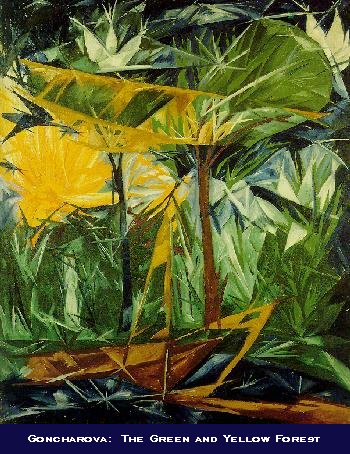

Goncharova was born in Negaevo, in Tula Province on June 16, 1881 and died in Paris on October 17, 1962. A descendant of the great poet Aleksandr Sergeevich Pushkin's wife, she was the daughter of Sergei Goncharov, an architect, and Ekaterina Il'ichna Beliaeva, but grew up in her grandmother's house in the Tula Province. She attended the Fourth Gymnasium for Girls in Moscow and in 1898 entered the Moscow School of Painting, Sculpture and Architecture as a sculpture student. At the school Goncharova met Mikhail Larionov who became her lifelong companion and encouraged her to leave sculpture for painting. Goncharova was attracted briefly to Impressionism and Symbolism, but her participation in the Golden Fleece exhibition introduced her to the styles of Gauguin, Matisse, Cezanne and Toulouse-Lautrec whose art would influence her development. In a series depicting the popular theme of the Russian peasants working the land, this influence is revealed in both color and the approach to form. In 1910, Goncharova became one of the founding members of the Jack of Diamond group but later went her separate way to establish the Donkey's Tail group with Larionov. In 1912, the artists of the group held their first exhibition with more than 50 works from Goncharova, executed in a number of different styles. Goncharova was a connoisseur of lubki, Russian popular prints, and the titles of her works clearly betray this influence. Her use of conventions of icon painting is particularly evident in the Evangelists.
In 1913, she began her most productive period, painting dozens of canvases. In her Neo-primitive works she continued to explore the styles of Eastern and traditional art forms, but also experimented with Cubo-futurism (see The Cyclist,
painted in 1912-13), and tried her hand on Larionov new style of Rayonism. Her famous Cats (1911-12) and Green and Yellow Forest (1912) show how confidently she was able to work in the Rayonist style, developing her own artistic idiom independently of Larionov. In August 1913, Goncharova attracted international attention exhibiting over 700 paintings in an one-woman show . During this period she was, like Larionov, associated with the literary avant-garde. In 1914 Goncharova visited Paris to make designs for Diaghilev's production of Le coq d'or. Her designs, based on Eastern and Russian folk art, took Paris by storm. She also held a joint exhibition with Larionov at the Galerie Paul Guillaume. She returned to Moscow after the beginning of the war. At the request of Diaghilev, Larionov and Goncharova left Russia for Switzerland in June 1915. In 1916, they accompanied Diaghilev to Spain and Italy. Spain left an everlasting impression on Goncharova. She was especially moved by the bearing of Spanish women in their
mantillas. From that moment on, Espagnoles became her favorite subject. In 1919, Larionov and Goncharova settled permanently in Paris; they were granted
French citizenship in 1938. During the Paris period, Goncharova became famous for her theatrical designs. In the 1920s, she developed her own
style for her series Espagnoles and for many paintings with bathers. Following Diaghilev's death in 1929, Goncharova's creative powers declined only to be briefly revitalized by the public rediscovery of Rayonism in 1948. After Larionov's stroke in 1950, Goncharova's health also started to decline, and although the couple married in 1955, their last years were spent in poverty. [S.C.] [Source : The Dictionary of Art].
